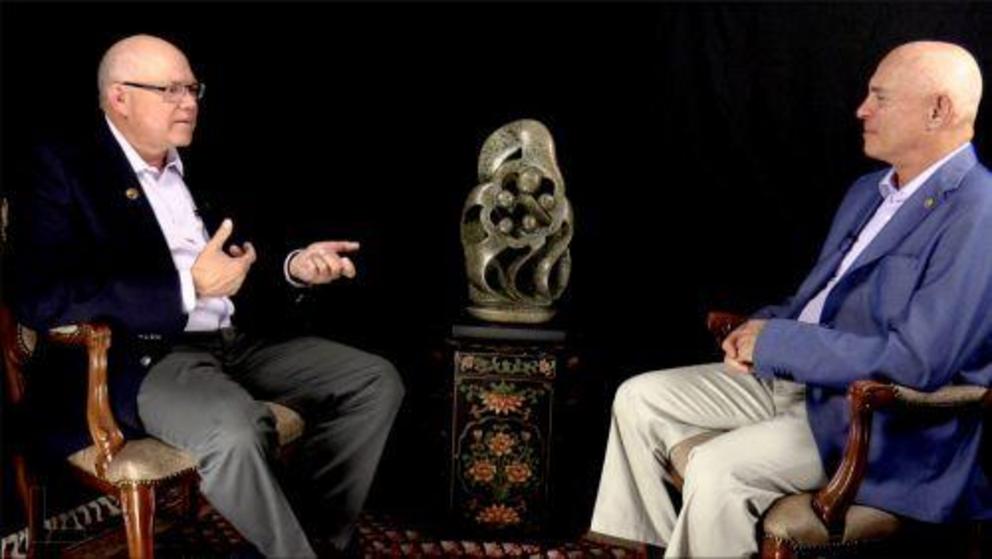Flavors of remote viewing
“It’s bewildering!”
That’s what new people entering the remote viewing world often think when faced with the many “kinds” of remote viewing they see there. What’s the difference between CRV, ERV, ARV, TRV, SRV (and that’s just the start), they want to know? In my book The Essential Guide to Remote Viewing I introduce readers to some of the better-known varieties. But I don’t go into much detail about how there got to be so many.

My comments here introduce my recent interview with Jeffrey Mishlove on his New Thinking Allowed vlog (linked at the bottom). But I also cover a few points that we didn’t get to in that interview.

Ted Koppel in 2008.
Remote viewing first became widely known to the public starting with Ted Koppel’s Night Line program on November 28, 1995. Not long before, the CIA had wrapped up a study of the 23-year-long intelligence community program exploring and using remote viewing as an collection tool, then terminated the program and started the declassification process. Soon, a few of the former military remote viewers began offering their versions of what had happened in the remote viewing program. And then a few more entered the public sphere, including myself.
Things ballooned from there, with folks who had taken one or more courses from the original Star Gate remote viewers launching out on their own as operators and/or teachers of remote viewing along with others who claimed (usually fraudulently) to have formerly been associated with Star Gate or with some shadowy, unidentified “foreign” intelligence service or military remote viewing program.
At the time of this first big revelation, three kinds of remote viewing emerged into public awareness: CRV (for “controlled remote viewing”), ERV (for “extended remote viewing”), and what I have come to call GRV (for “generic remote viewing”–the personalized techniques that the early remote viewers developed before any of the methodologies came into being). There was also ARV (for “associative remote viewing”), which is not a way of doing remote viewing, but rather a way of using it. And that was it. But by the turn of the century (five years later!), there were several more kinds of “xRVs” (which I use as a collective term for the ever proliferating varieties of RV), including at least two more variations on CRV.
Why did this happen? Three reasons:
- New people entering the field with ambitions of starting their “own thing” injected previous beliefs they brought with them or developed new ideas (or both) with which they then modified or replaced parts of the original remote viewing methods.
- Some of those developing new flavors of remote viewing (including some who had formerly been military remote viewers) were simply “branding” their own efforts. They changed the standard remote viewing processes enough so as not to be accused of simply copying the original methods, and then came up with a new name or acronym to distinguish their modified approach from the original.
- There were those who introduced changes for purely marketing reasons. They wanted to distinguish their product from others, so they came up with a new name and introduced modifications so that, again, they could lay claim to something new or advanced in the remote viewing domain.
- And sometimes elements of all three of these motivations came together in the formation of new xRVs.
Some think the remote viewing world is unique in how all this has unfolded. But in fact these behaviors are fairly typical of human endeavor in new or developing fields. I’m sure most readers can think of one or another example where an emerging field or technology attracted numerous innovators and imitators who adopted just these sorts of strategies and behaviors.
Many of the changes that result in new “xRV” flavors are merely cosmetic. Often those making them think the changes are for the better. But that is not always the case. Sometimes the alterations are the equivalent of taking the word “glad” out of a sentence and replacing it with the word “happy,” thinking you have improved the text. Certainly, a difference has been created. But it is a difference without a distinction. In remote viewing sometimes these differences are indeed simply vocabulary changes–substituting one word or phrase for another in a remote viewing system’s terminology. However these changes are intended, they often just alter the appearance of the process without making any real difference to the substance. This is true of a number of second and third generation remote viewing methods.
Other changes actually degrade the remote viewing process. The original remote viewing protocol and methods (which include CRV, ERV and—to be fair—many form of GRV) were the result of years of extensive research and thousands of trial-and-error experiments.
The people who developed them learned as much about what didn’t work as what did, and those lessons-learned are incorporated into the methodologies that were revealed along with the public disclosure of the existence of the remote viewing program itself.

Dr. Harold E. “Hal” Puthoff and Ingo Swann were the key developers of the CRV method.

F. Holmes “Skip” Atwater was the primary developer of ERV.
Without having done nearly as much experimentation and research, too many of the new generations of practitioners and teachers are “changing” principles and practices that for very good reasons were part of the original methodologies. (Unfortunately, those doing the changing have been encouraged in this by what they’ve seen some of the more controversial original Star Gaters themselves do.) It shouldn’t be surprising that as some of these folks “reinvent the wheel,” they may end up with a wheel that has square corners.
On the other hand, some newly-introduced alterations may actually be improvements. Given that we know more today about human psychology and perception, as well as extrasensory perception (ESP) itself than was known at the time the original methods were developed, it makes sense that there might be things that could be introduced to improve remote viewing functioning. But for such improvements to be real, the people making them have to have actually studied this new scientifically-developed information. While from what I’ve seen that is sometimes the case, far too often it is not.
The problem, of course, is there’s no quality control. And there’s also no independent testing or licensing organization to evaluate newly introduced elements. In some ways that’s good; it leaves lots of room for innovation. In other ways it’s bad; almost anything can be introduced and claimed to be “better,” and it’s hard for the average person to know if it really is.
Beginning about page 210 in Chapter 13 of my book, The Essential Guide to Remote Viewing, and also in the “What to Beware Of” section (p. 252) in Chapter 15, I give some general guidelines that are relevant to this topic. In the meantime, the following video interview between myself and Jeffrey Mishlove, Ph.D. dives into the subject of how remote viewing got started and the question “where did all the xRVs come from?” Enjoy!

